Join in the celebration of Gemini Observatory’s one-thousandth scientific paper by becoming a friend of Gemini on Facebook (click on the "Like" button above to join Facebook friends of Gemini). Here, you can follow along, through the end of 2011, as some of the top science results (and dozens of stunning images) from the twin 8-meter Gemini telescopes are featured each week in “Gemini Gems.”
Click on the banner at the top of this page to go to the press release.
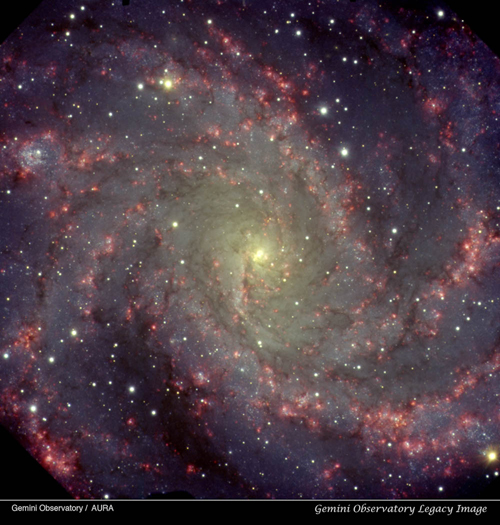
Bringing in the New Year with Celestial Fireworks! December 29, 2011
Dubbed the “Fireworks Galaxy” this spiral galaxy is named for its great number of supernovae explosions over the past century. In addition it shows many areas where stars are being born. Learn more about this galactic fireworks factory at:
http://www.gemini.edu/index.php?q=node/116
The staff of Gemini Observatory hopes you have enjoyed the last two months of Gemini Gems. If you have missed any of these featured stories see the archive at:
http://www.gemini.edu/geminigems

Dwarf Planets at the Edge of our Solar System December 28, 2011
Studying the outer reaches of our Solar System, Gemini has played a critical role in characterizing a range of objects that lie beyond Pluto (which would eventually take names like Sedna, Eris, and Haumea). These studies helped to seal Pluto’s demotion to dwarf planet status. Learn more with these stories in Gemini’s science archive:
http://www.gemini.edu/node/126
http://www.gemini.edu/node/142
Tomorrow’s final Gemini Gems features an image that will bring in the new year with a display of celestial fireworks!
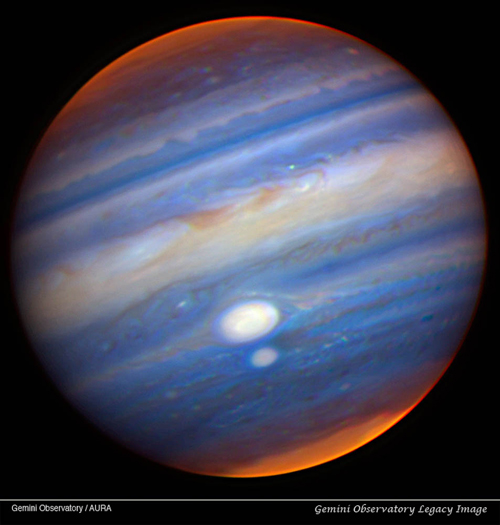
Jupiter’s Red Spots December 27, 2011
Back in 2006, Jupiter’s famous Great Red Spot was accompanied by a smaller, but similar feature dubbed “Red Spot Junior.” While they both moved along Jupiter’s bands at different rates, in July of 2006 Gemini captured this image using adaptive optics to reveal remarkable details in the giant planet’s atmosphere. Learn more at:
http://www.gemini.edu/node/196
Tomorrow’s Gemini Gem highlights work done by Gemini at the extreme edges of our solar system. Follow the Gemini Gems Facebook features on Tuesday, Wednesday, and Thursday of each week until the end of 2011.
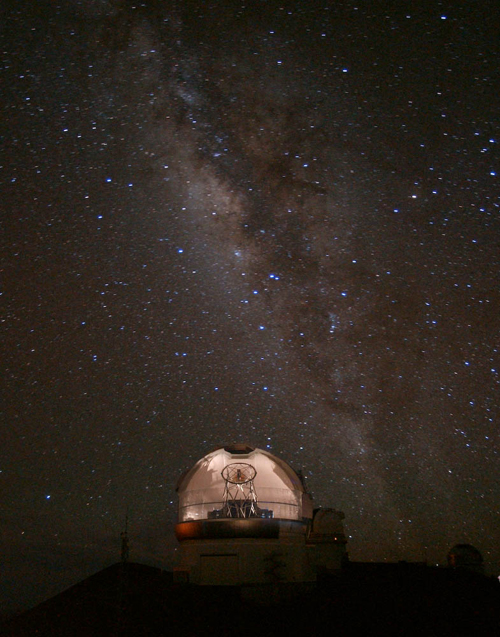
"Cloaked" Gemini December 22, 2011
This time lapse image shows the Gemini North telescope inside the dome which usually protects and covers the telescope. However, because the dome rotated as these digital shots were obtained, the entire dome seems to become transparent once the individual images were joined into one. Learn more at:
http://www.gemini.edu/gallery/v/gn/exterior/GNInvDomeVertSmall.jpg.html
Next Tuesday’s Gemini Gem shows the planet Jupiter in an uncommon light. Follow the Gemini Gems Facebook features on Tuesday, Wednesday, and Thursday of each week until the end of 2011.

Most Distant Quasar December 21, 2011
Quasars are very bright objects from the young universe which provide astronomers a glimpse back to the state of the youthful universe. In this Gemini Gems highlight, astronomers led by David Mortlock of the UK used Gemini to study what is thought to be the most distant quasar ever studied. It's light, from a period only about 770 million years after the big bang, was examined by Gemini using spectroscopy with the Gemini Near-Infrared Spectrograph (GNIRS). Find out more at:
http://www.gemini.edu/node/11649
Watch for tomorrow’s Gemini Gem, an image of the Gemini North telescope revealing secret "cloaking" technology used to show the entire telescope from outside. Follow the Gemini Gems Facebook features on Tuesday, Wednesday, and Thursday of each week until the end of 2011.

Galactic Dancers December 20, 2011
Two galaxies in a gravitational embrace gracefully pirouetting around each other. Ultimately, in millions of years, they will meld each other into distorted images of what we see today. Each of these galaxies share similar shapes to what we think our Milky Way would look like from afar, but their embrace will likely change that likeness over time. The red areas in each galaxy are regions where star formation is ongoing.
http://www.gemini.edu/node/10979
Watch for tomorrow’s Gemini Gem on a distant quasar near the edge of our vision. Follow the Gemini Gems Facebook features on Tuesday, Wednesday, and Thursday of each week until the end of 2011.
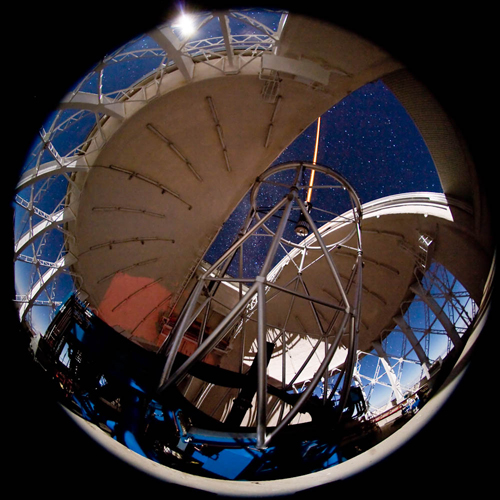
Lasing Stars December 15, 2011
When using adaptive optics, there simply aren’t enough stars in the sky to correct for atmospheric distortions to starlight. So astronomers use a laser, like the one shown in this image, to make artificial stars anywhere they are needed to sample the effects of our atmosphere on starlight. This information is then used to correct “bent” starlight with deformable mirrors. The laser is visible in this image as the yellow/orange line propagating out from the top of the telescope.
http://www.gemini.edu/gallery/v/gn/lgs/20070821_gn_mk_3d_tl_0821-2207_c2191.jpg.html
Next Tuesday’s Gemini Gem reveals a pair of interacting (colliding) galaxies doing a graceful galactic dance that will likely meld them into one – many millions of years from now. Follow the Gemini Gems Facebook features on Tuesday, Wednesday, and Thursday of each week until the end of 2011.

A Nobel Endeavor December 14, 2011
The 2011 Nobel Prize in physics was awarded for the discovery of the acceleration of the universe and the resulting concept of dark energy that propels it. Gemini continues to play a supporting role in this work and helped to refine values for the rate of universal acceleration. Learn about the 2011 Nobel Prize and Gemini’s contribution to the ongoing research at:
http://www.gemini.edu/node/11688
Tomorrow’s Gemini Gem image will take you inside the Gemini North dome while the laser guide star system is propagating. Follow the Gemini Gems Facebook features on Tuesday, Wednesday, and Thursday of each week until the end of 2011.
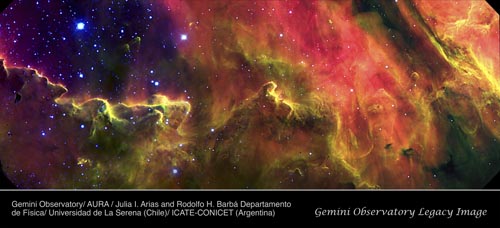
A Stellar Nursery in “Technicolor” December 13, 2011
Captured in three fields using the Gemini Multi-Object Spectrograph in its imaging mode, today’s Gemini Gem reveals striking emission-line colors of the Lagoon Nebula. See the full image and details about how scientists are using this data at:
http://www.gemini.edu/node/11631
Tomorrow, take a look at how Gemini has helped to refine our understanding of the accelerating universe through observations of distant supernovae. Follow the Gemini Gems Facebook features on Tuesday, Wednesday, and Thursday of each week until the end of 2011.
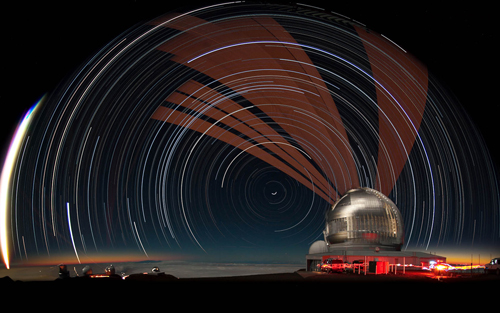
Laser Night December 8, 2011
Today’s Gemini Gem image captures a night (sunset to sunrise) on Hawaii’s Mauna Kea with the Gemini laser guide star system propagating on the sky. This system can produce an artificial star anywhere in the sky and then used to sample turbulence in the Earth’s atmosphere and correct for distortions to starlight. Learn more at:
https://gemini.edu/gallery/gemini1101c
In next Tuesday’s Gemini Gem, a portion of the Lagoon Nebula is revealed in stunning, colorful detail. Follow the Gemini Gems Facebook features on Tuesday, Wednesday and Thursday of each week until the end of 2011.

Explosive Glimpses Back in Time December 7, 2011
Gamma ray bursts are nature’s brightest and most energetic explosions. They allow astronomers to look back in time at the very early universe - the only caveat is that they are fleeting and we need to catch them while they are “fresh!” Queue scheduling makes Gemini especially well-suited for this work and you can find out more here:
http://www.gemini.edu/node/11634
http://www.gemini.edu/furthestgrb
Watch for tomorrow’s Gemini Gem image of the laser guide star system at on the sky from sunset to sunrise at Gemini North. Follow the Gemini Gems Facebook features on Tuesday, Wednesday and Thursday of each week until the end of 2011.

Interstellar Cavern December 6, 2011
Known as the N44 superbubble complex, this Gemini Legacy image from January of 2006 has inspired numerous imaginative interpretations of its likeness, from a giant snake jaw to a stellar cavern. Regardless of your interpretation, enjoy this beautiful image and learn more about it at:
http://www.gemini.edu/node/171
Tomorrow’s Gemini Gem will feature nature’s brightest explosions – gamma ray bursts which astronomers use as probes to study the early universe when is was very young. Follow the Gemini Gems Facebook features on Tuesday, Wednesday and Thursday of each week until the end of 2011.

Saturn and Moon Titan December 1, 2011
Saturn posed for this beauty-shot in near-infrared light using adaptive optics for the sharpest possible view. Note the small circle below, this is Saturn’s largest moon Titan. Adaptive optics allowed scientists to monitor weather on Titan in this story from August 2009.
http://www.gemini.edu/index.php?q=node/11305
Next Tuesday a classic Gemini image showing a huge interstellar cavern within a star-forming region will be our featured Gemini Gems image. Follow the Gemini Gems Facebook features on Tuesday, Wednesday and Thursday of each week until the end of 2011.
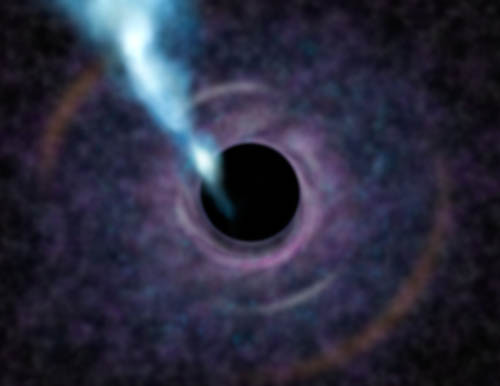
The Black Hearts of Galaxies November 30, 2011
Like our Milky Way Galaxy, most galaxies appear to have black holes at their centers. Gemini instruments like the Near-Infrared Spectrograph (NIFS) and Gemini Multi-Object Spectrograph (GMOS) provide spectroscopic "maps" of their environments, which reveals the masses of these black holes or their feeding habits. Sample Gemini's work in this area with these links:
http://www.gemini.edu/node/11588
http://www.gemini.edu/node/11340
http://www.gemini.edu/node/174
The solar system’s most distinctive planet is featured in tomorrow’s Gemini Gems. Follow the Gemini Gems Facebook features on Tuesday, Wednesday and Thursday of each week until the end of 2011.
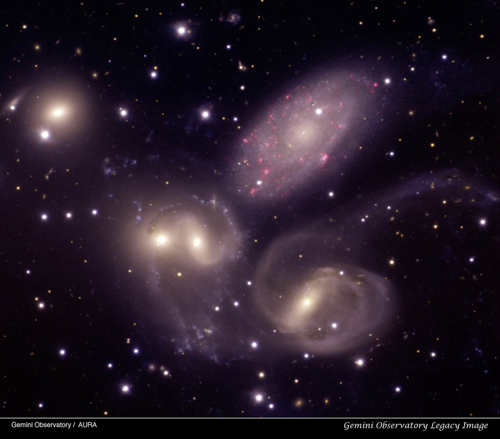
Stephan’s Quintet November 29, 2011
Stephan's Quintet as imaged by Gemini North. The interacting members of the cluster are almost 300 million light years away. The galaxy NGC 7320 (top–center) is thought to be in the foreground and is distinguished in this image by multiple red blobs of hydrogen gas where stars are forming.
http://www.gemini.edu/index.php?q=node/68
Check Facebook tomorrow for a look back in time to some of the most massive black holes known which are located at the centers of galaxies. Follow the Gemini Gems Facebook features on Tuesday, Wednesday and Thursday of each week until the end of 2011.
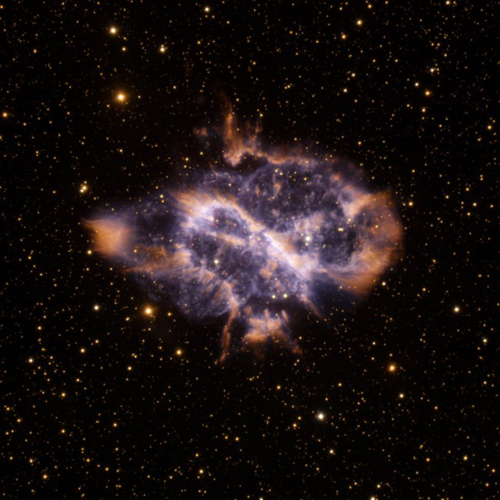
Chaotic Outflows November 24, 2011
This is not your ordinary planetary nebula with symmetrical bubbles of gas, instead, NCG 5189 is a chaotic mess of streamers, knots and seeming disorder. What causes this apparent randomness is not understood but it makes for an interesting example of the variety of structures that planetary nebulae can display.
On Tuesday, November 29th, the Gemini North image of Stephan’s Quintet will light up your Facebook screen. Learn more by following the Gemini Gems Facebook features on Tuesday, Wednesday and Thursday of each week until the end of 2011.
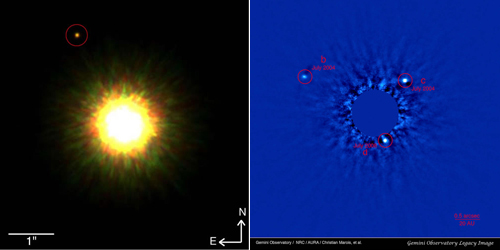
Direct Imaging of Exoplanets November 23, 2011
Gemini’s direct imaging of planets around other stars represents a milestone in the exploration of extrasolar planets. Previously planets were detected by indirect means but with direct imaging more can be learned about these worlds and these discoveries point the way to many more exciting discoveries as the Gemini Planet Imager reaches completion.
http://www.gemini.edu/node/11486
http://www.gemini.edu/threeplanetspr
http://www.gemini.edu/sunstarplanet
Look for tomorrow’s image of the chaotic planetary nebula NGC 5189 which defies the symmetry often seen in outflows from old mid-sized stars like our Sun.
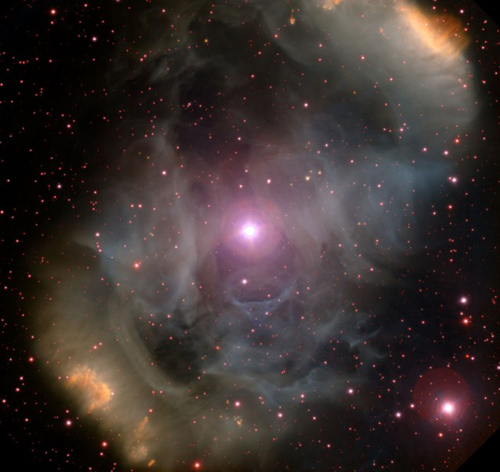
Belching Giant November 22, 2011
A giant star at least 40 times the mass of our sun belches material into space. With relatively short lives, the middle-aged star responsible for this bipolar outflow is only about 3-4 million years old.
http://www.gemini.edu/node/188
Tomorrow’s Gemini Gem celebrates two of Gemini’s most significant results, the direct imaging of planets around another stars.

Orion’s Bullets November 17, 2011
Bullets from a stellar nursery? As odd as that sounds, that’s exactly what this image shows as concentrations of gaseous iron race through hydrogen gas and cause it to glow. The gassy iron bullets are being ejected from a star forming region to the lower left (and out of the image) at speeds of up to 400 kilometers per second.
http://www.gemini.edu/node/226
A belching massive star will be the next Gemini Gems feature on November 22nd and features outflows from a star more than 40 times the mass of our Sun.

Debris Disks November 16, 2011
In this result from November 2007 highlights the discovery of hot dust around a star in the Pleiades star cluster. The research team concluded that the data indicate the likely remains from collisions in an evolving young planetary system. http://www.gemini.edu/node/259
Related stories at:
http://www.gemini.edu/node/11522
http://www.gemini.edu/node/11385
http://www.gemini.edu/node/222
http://www.gemini.edu/node/183
http://www.gemini.edu/node/138
http://www.gemini.edu/node/117
Tomorrow’s Gemini Gem brings supersonic bullets into focus from Orion’s stellar famous stellar nursery.
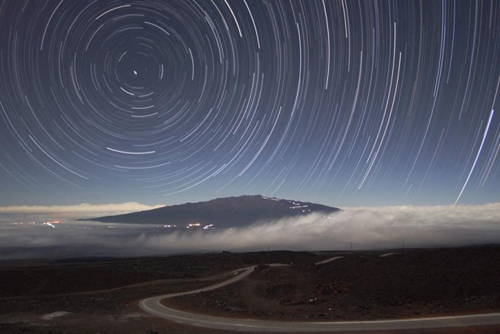
Stars Over mauna Kea November 15, 2011
A timelapse image of Mauna Kea from Mauna Loa by moonlight captures an evening in the “life” of the tallest mountain on the Earth (as measured from the ocean floor). Learn more about this image and how it was obtained at the Gemini Gems Archive.
https://gemini.edu/gallery/gemini-maunakea-inversion
Watch for more Gemini Gems highlights on Facebook through the end of 2011. Tomorrow learn about Gemini’s exploration of Debris Disks where its likely that planets are forming around young stars.

Bipolar Star Birth November 10, 2011
Acquired to test new filters on the Gemini Multi-Object Spectrograph, the February 2010 release of the bipolar stellar nursery called Sharpless 2-106 captures all of the intricate details in this chaotic star forming cloud some 2,000 light years away. Learn more at:
http://www.gemini.edu/node/11410
Watch for more Gemini Gems highlights on Facebook through the end of 2011. Next week (Tuesday, November 15th) look for one of Gemini’s most popular images of the Earth, specifically, Mauna Kea in all its splendor!
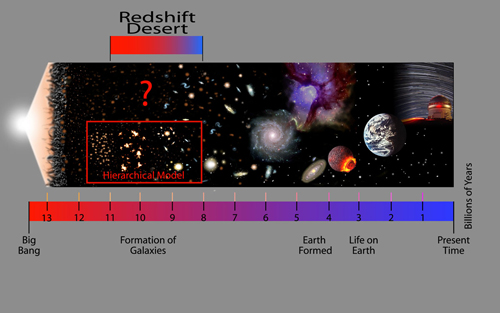
Feeling Young, Looking Old November 9, 2011
Probing far back in time to when the universe was extremely young, the Gemini Deep Deep Survey (GDDS) revealed that galaxies in the young universe looked much more mature than expected. This Gemini Gems result also looks back in time with Gemini to 2004 when the GDDS team announced these first findings at the January 2004 meeting of the American Astronomical Society. Learn more at:
Related stories at:
http://www.gemini.edu/node/193
http://www.gemini.edu/node/18
http://www.gemini.edu/node/8
Watch for more Gemini Gems highlights on Facebook through the end of 2011. Tomorrow be sure to check out the intricate details in the Gemini Gems image featuring a stellar nursery gone bipolar!
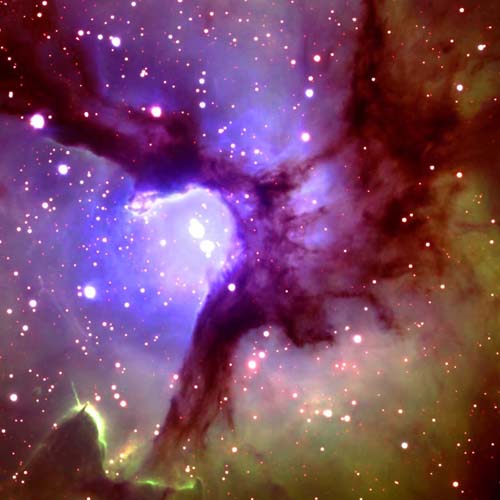
A Heart of Star Birth November 8, 2011
Today’s Gemini Gems image was one of the Gemini Observatory’s first Legacy Image releases to demonstrate the powerful imaging capability of the Gemini Multi-Object Spectrograph. This image of the center of the Trifid Nebula (M 20) was the result of a student imaging contest in Canada. Learn all about this image at:
Watch for more Gemini Gems highlights on Facebook through the end of 2011. Next up is a story about work done by Gemini called the Gemini Deep Deep Survey (GDDS) which revealed that galaxies in the young universe looked more mature than expected. See “Feeling Young, Looking Old” on Facebook on November 9th.
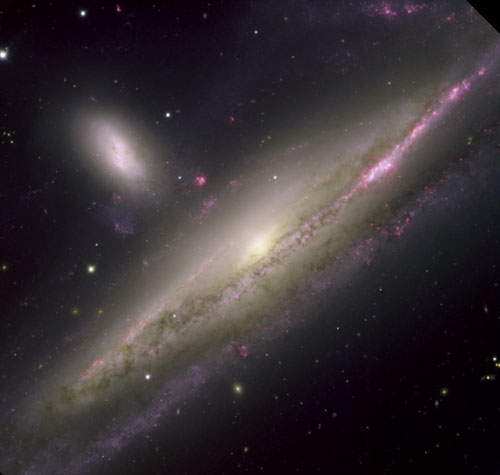
Waltzing with the Stars November 3, 2011
Today’s Gemini Gems image captures the embrace of the two interacting galaxies, NGC 1531 and 1532. Originally released in December of 2004, this image illustrates both the interaction of galaxies and the star forming regions in a large edge-on spiral galaxy. Experience this image in all its splendor at:
http://www.gemini.edu/node/119
Look for more Gemini Gems highlights on Facebook through the end of 2011. Watch for the next image “A Heart of Star Birth” on November 8th.
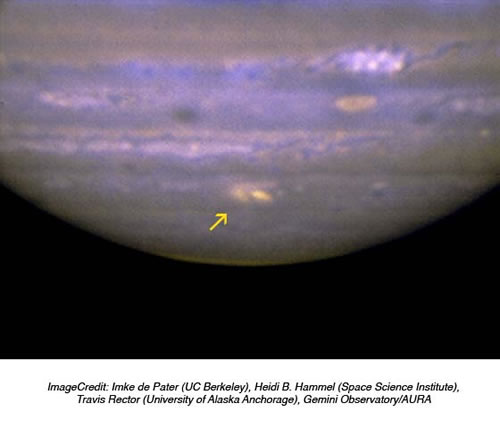
Jupiter’s Ballistics November 2, 2011
Enjoy today’s Gemini Gems release celebrating 1000 papers based on Gemini Observatory observations. This result is from July 2009 and is an example of how violent our solar system is when worlds collide - like this explosion high in Jupiter’s clouds indicated by the arrow on this Gemini image. See original press release for details.
Related stories:
Without a Trace - A Flash in Jupiter's Sky
2009 Collision with Jupiter - On the Rocks
Watch for more Gemini Gems highlights on Facebook through the end of 2011. Catch the next Gemini Gems image release "Waltzing with the Stars" on November 3th.
